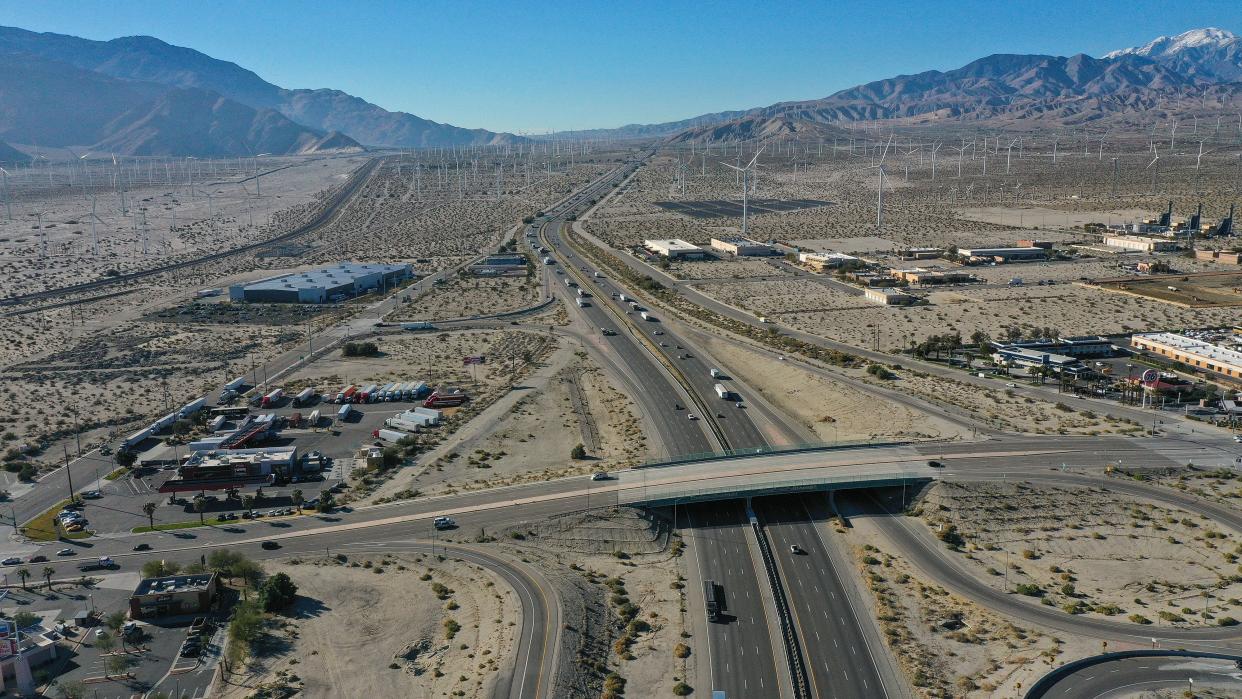Palm Springs should hold off on mega-warehouses so valley can work together

As you first drive into the western edge of the Coachella Valley, you can see the desert spreading toward the mountains.
It’s a visitor’s first glimpse of the natural beauty that helps draw tourists here and powers our economy.
And much of it is still unspoiled, at least for now.
On Thursday evening, the Palm Springs City Council could give final approval to a plan to allow mega-warehouses and their ilk, some up to 95 feet high, in the far north end of town around Interstate 10.
A “game changer,” City Manager Justin Clifton said at a council meeting two weeks ago.
He meant it as a good thing: a nod to the tens of millions in new tax revenue the city projects it would get.
But the massive centers companies want to put in the valley could be a game changer in other ways, too.
They have different purposes and names: warehouses, distribution centers, fulfillment centers.
But they all look more or less the same: hulking windowless concrete boxes that power ever-more efficient modes of modern retail.
Some send goods to store shelves, while the tallest — the 95-footers — would hold all the things we order online.
City staff said these buildings could be 200,000 to over 1 million square feet. That’s like five Costcos put together.
A 95-foot-tall warehouse would be about the height of a 10-story building, more than half as high as the Agua Caliente resort in Rancho Mirage — and a lot wider.
Warehouse-like centers are already allowed in that part of Palm Springs, but only up to 40 feet high.
More than doubling that would allow the kind of buildings retailers use now, which use incredibly tall racks to store goods, city planning director Flinn Fagg told the council earlier this month.
Allowing them in Palm Springs could lead to more around the valley, leaving parts of our desert looking like generic stretches of the Inland Empire, rather than the unique treasure it is.
It’s only a bit far-fetched to envision such warehouses dotted regularly along the 25 miles of freeway from the windmills to Indio.
Why? If the projections are true and Palm Springs gets an extra $20 million to $40 million a year in sales taxes — at the high end, that would increase total city revenues by 30% — won’t every city want the same?
They might end up concentrated in west valley because of geography, though: It’s the most logical place in the desert to send goods headed for the valley from the ports of Los Angeles and Long Beach.
Under the plan Palm Springs is considering, the tallest warehouses wouldn’t be smack dab against the freeway: anything over 30 feet would be 1,000 feet from the I-10 right-of-way.
But on a flat desert floor, 1,000 feet isn’t much.
The objections here are more than aesthetic: There are environmental and traffic concerns about more trucks and more open land paved over.
Yet we don’t think the Palm Springs council should simply reject the idea. As surely as the tides come in, these centers will probably be in the valley one way or another.
People are buying more things online than ever, and they want everything yesterday. There are real benefits to the new centers: customer convenience, jobs and that tax revenue.
But we can be more thoughtful about how we allow them. Instead of cities jockeying to be first, the region could come together — imagine! — and agree to share the revenue.
The warehouses won’t stock goods just for people in Palm Springs, so why should $40 million a year in tax revenue go only there?
A revenue-sharing deal would allow the money and the jobs to still come to the valley while benefiting everyone.
One risk of Palm Springs rejecting the latest and biggest centers is that they’d just end up in poorer areas in the east valley. More of the residents there, especially in unincorporated areas, are people of color with less political clout.
For now, Thursday’s council vote in Palm Springs is scheduled to happen without debate on the consent agenda, since a public hearing and council discussion happened Jan. 13.
But it can be pulled off that consent calendar for a separate discussion and vote.
If you want to speak at the meeting, you can call the city clerk at 760-323-8204 to register during the day Thursday. (The council's public session begins at 5:30 p.m.)
Palm Springs council members should be wary about allowing these massive new buildings just to respond to the siren’s call of jobs and tax revenue.
Large corporations seem to have a magical way of getting out of paying as much in taxes as the early numbers suggest.
And as automation grows more ruthlessly efficient, many of the jobs could go away
Retail is always evolving. Many malls built in the 1970s and ’80s have died, or nearly so. Big-box stores that gained popularity in the 1990s were then overbuilt, and many of our communities have struggled to fill those white elephants for years.
Will the same happen with these huge fulfillment centers? Maybe, maybe not. But it is worth examining the lessons of the past before rushing headlong down this new road.
Once we build on these landscapes, we can never get them back.
This article originally appeared on Palm Springs Desert Sun: Palm Springs, Coachella Valley should work together on warehouse plans

